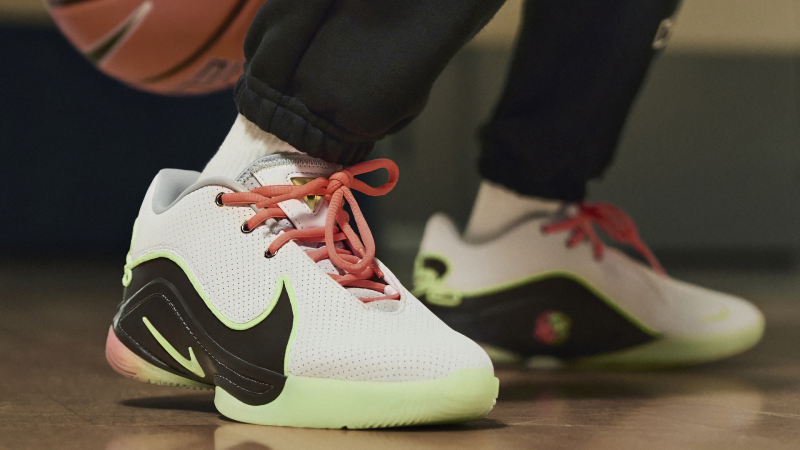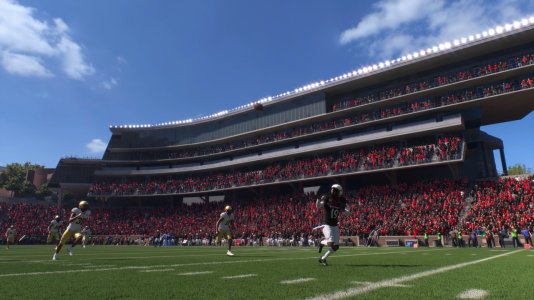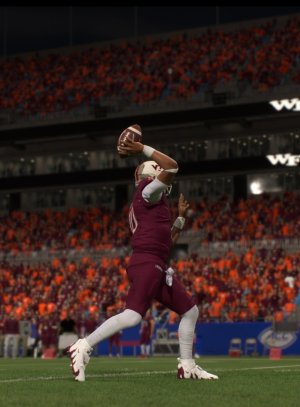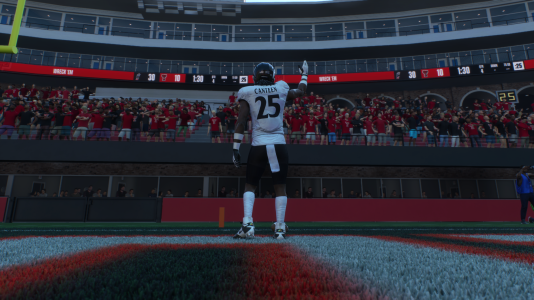[h1]
'NCAA Football 14': A first-look preview[/h1]
I’ve been running the virtual option since “Bill Walsh College Football” on the Sega Genesis. That makes me either a wishbone expert or just plain old (although I’ll settle for being an old expert).
So when I got my hands on “NCAA Football 14” for the first time at a special preview event in San Francisco, and some of the featured points of emphasis about the new game were all of the enhancements made to the option, I seriously spent the next 20 minutes reading the outside linebacker and either pitching the ball wide, or tucking it down and running as the Oregon Ducks. And I couldn’t get enough.
And for gamers unfamiliar with how to run the various option plays, EA Sports is ready to teach you, even designating icons above certain defenders’ helmets to alert the offensive player about positioning, and whose movements in particular they need to read. So while running the read option to the right, the left outside linebacker will have a No. 1 over his head, and if he cuts inside, you’ll learn to pitch the ball to your running back. If the linebacker plays outside, then it’s time for the quarterback to keep the ball himself, cutting up inside the linebacker as he tries to work his way into the open field. Other plays, the linebacker will be the first read, but a defensive back will be the second read, so depending on the call, you might keep the ball when you see the linebacker get blocked, but when the safety moves up to make a play, you pitch the ball to your running back at the last second and try to work the sidelines for a long run.
“We’ve gone crazy overboard revamping the option game this year,” said Larry Richart, “NCAA 14’s” central game-play designer. “There are 31 different option types in our game now, which include all the different veer options, shotgun full triple options, shovel options, the Pistol … any type of option play you can think of. We want to teach the user what they should be doing, because if you don’t know how to run the option, it can be complicated, it can be scary, and in years past, calling these plays, a lot of people didn’t know when to pitch, they didn’t know when to keep it, so now you’re going to see the defender you’re supposed to be looking at, and depending on what he does, you’ll either pitch it or keep it. The guys you’ll need to read will be indicated, and you’ll know the order you’ll need to look at them. We’ve even added new animations to the defense where you’ll see the defender shoot out or attacking the quarterback right away, so you’ll know right away what he’s doing in order to make the right play.”
The open-field targeting of blocking receivers has also been completely revamped, so now your receivers will actually block the right players from the right position on the field, opening up new running lanes that just weren’t there before. You’ll even see the offensive linemen making it to the second level and targeting the safeties, no longer content to simply block any player in sight.
“We went through every single option play and determined who every guy should block, and who they should leave unblocked,” Richart said. “We’ve totally revamped the logic to go with brand-new animations and plays.”
The option pass has also been boosted. Where last year you had to hit A to snap the ball, then A again to bring the icons up, and by that time, your quarterback was stuck in some drop-back animation, eliminating all hope of a bubble screen and most likely leading to a sack, in “NCAA 14,” the option pass is now simply a play-action pass, with the game automatically going through the option fakes, allowing you to set up your passing play more quickly. And with the enhancements made to downfield blocking, the bubble screens are increasingly effective this year, as your players finally block the appropriate defenders in front of you as you take off for the first down.
There’s even a new spread option playbook available that features all of these new plays and option types. That includes more than 20 new formations and 350 new plays to go along with a skill training practice game that will have you running the option like a champ. Then again, all of these improvements also carry over to CPU teams, so get ready to give up some yards on the ground this year if you’re not ready to defend all of these new option plays.
Added “NCAA 14” producer Ben Haumiller: “The computer is much smarter about using moves, getting to the outside, and timing the pitch.”
But the improvements to the option game aren’t the only big additions, as “NCAA Football 14” will finally reveal the enhancements made to the EA Sports Infinity physics engine. Last year, the new real-time physics system was left out of the “NCAA” series, angering fans who felt like it once again relegated the college game to “Madden’s” little brother status. But with Infinity Engine 2.0 debuting in “NCAA 14,” fans are going to see what another full year of tweaks can add to the game play, and the difference is downright staggering (not to mention, smooth). Gone are all the problems you saw in “Madden” with players randomly tripping over a foot and falling down (now they’ll actually step over random limbs), or teammates rolling all over each other, twisting their legs, and flipping around after the play was already blown dead.
“This is a much more mature version than what you played in ‘Madden,’” Richart said. “But the big thing is, it’s physics you can play. We put a greater emphasis on the ball carrier, and now with the Infinity engine, you can really emphasize stiff-arms. In the previous version, you’d run, and when you pressed the stiff-arm button, it was a dice roll whether you hit or not. This year, you can see the ball carrier really punch. We added all new animations, and now you can hit the defender in the face mask, you can hit him in the shoulder, and depending on where you hit him, you’ll see him react differently to the move. Also, with the Truck Stick, you don’t have to worry about that silly NFL rule with the crown, and you’ll notice much more forceful impacts where the ball carrier can deliver the blow and you’ll see the defender fall back in much more natural, organic reaction.”
Runners will also be able to fend off defenders, pushing and shielding their way past a would-be tackler, even if they don’t smack them in the chops. Running backs will have more contextual awareness than years past, avoiding blocking linemen in a game-play tweak EA is calling “ball carrier avoidance.” “Madden 13” suffered from running backs flying into the offensive line, then falling down because they ran into the back of their guard or tackle. In “NCAA 14,” the running back will stick his hand out and sidestep the blocker instead of making things easy on the defense by falling backward to the turf.
Also new is a stumble recovery system, where gamers can flick either up or down on the right stick when their ball carrier trips. Pull back on the stick, and you can try to recover and keep running, or if you feel like you might be in jeopardy of taking a vicious Hit Stick from a nearby defender, you can simply flick forward to dive ahead while protecting yourself and the ball.
Running locomotion has also been improved so direction changes will actually incorporate players making cuts as opposed to zigzagging their way down the field like past iterations. Auto sprint has also been removed in favor of an acceleration burst mechanic. So now, players won’t be running at full speed at all times. Using the right trigger, you’ll be able to burst when you feel like you need to hit that extra gear. But it’s not like you can turbo your way up and down the field at no cost, as EA has also added a fatigue meter at the bottom of each player, letting you know how much energy you have on every play based on individual player ratings, and the more you do jukes, cuts and sprint, the more you’ll notice your meter drop dramatically.
“At the end of a play, if you run out of energy, you’ll see it on screen in their running motion and style,” added Richart. “You’re basically out of gas.”
For hard-core fans, EA Sports has even added the ability to call plays based on personnel. This new play-calling type is based on the number of backs, tight ends and receivers on the field, and you’ll now be locked into calling audibles that match your personnel (gone are the days of audibling between goal line and five wide to gain an advantage over defensive matchups by having a receiver running routes from the fullback position). This will also take away the bug “NCAA” has had the past couple of years, where the CPU would come out in Wildcat, then audible into shotgun and try to throw a pass while the running back is locked in playing quarterback.
But don’t think all of the improvements are limited to the offensive side of the ball, as the EA Sports crew seems to watch Jadeveon Clowney hits on constant loop at the office, putting added emphasis on polygon smashing thanks to the evolution of the Infinity engine.
“The new physics also come into play on defense with the Hit Stick,” explained Richart. “There are a lot bigger collisions in the game this year, especially when you see a bigger defender square up on a little guy. You’re going to see train wrecks out there. The Hit Stick is back. I know people have felt that it has just been OK the past few years, and it wasn’t like it used to be, but with the new Infinity engine, you really feel the impact of the Hit Stick and dive tackles. Now when you dive at a runner, the force of the dive really exerts the momentum of the force, and the physics will take care of the rest.”








































